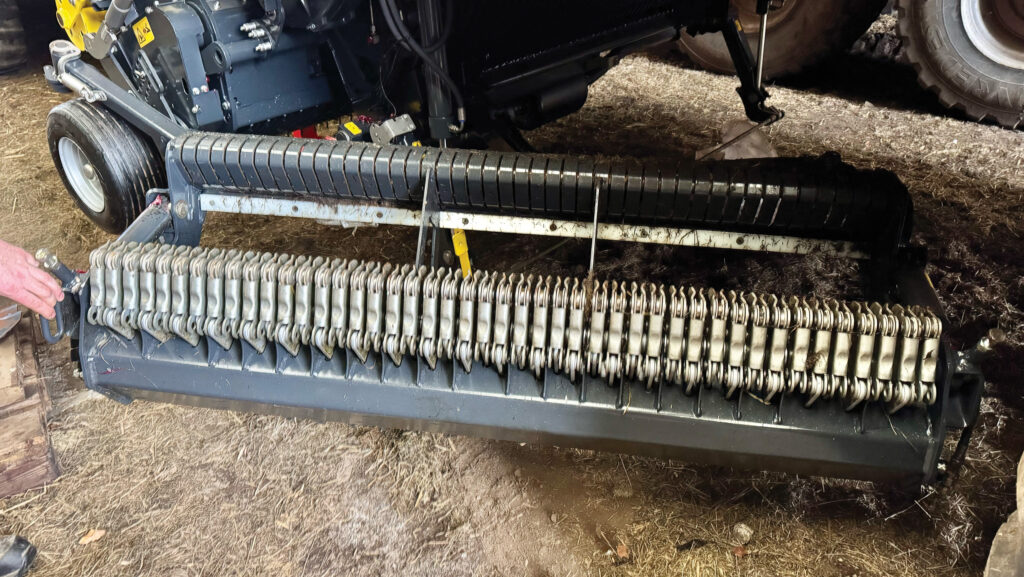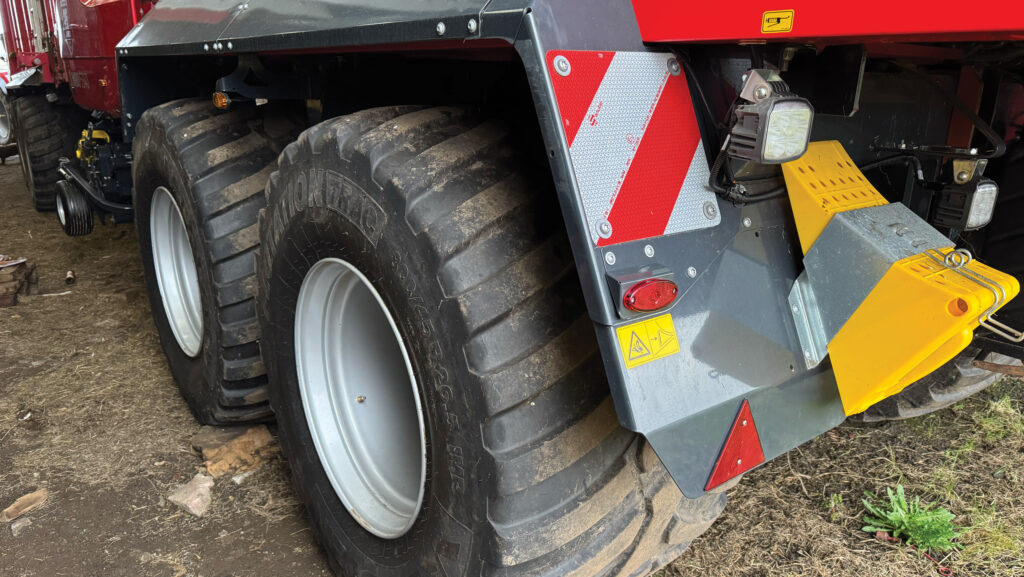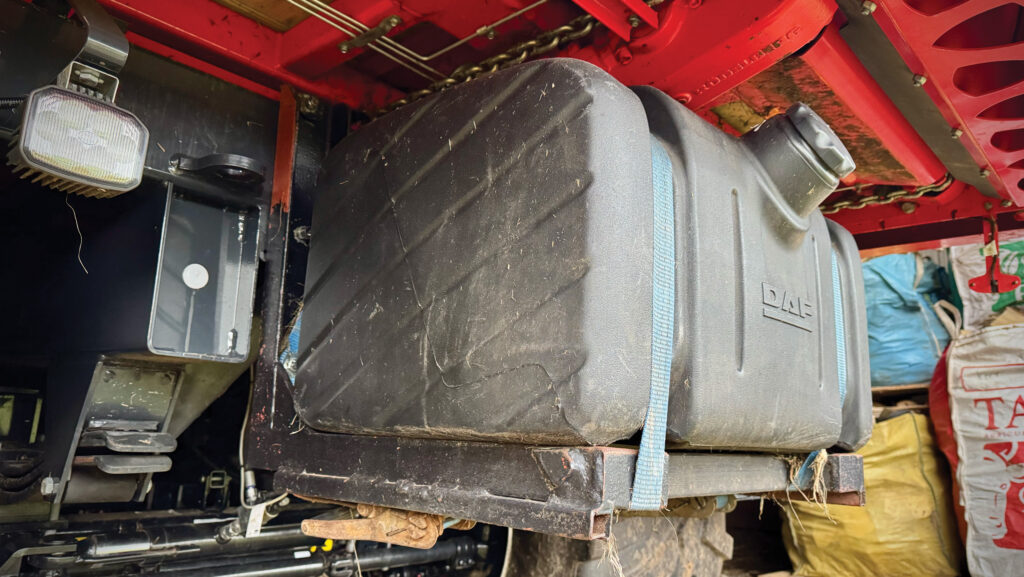Driver’s view: James Ireland’s Pottinger Jumbo 5340
 © MAG/Oliver Mark
© MAG/Oliver Mark Pottinger introduced a new Jumbo model last summer, promising the features of its big 7000- and 8000-series forage wagons in a cheaper and more compact package.
There are six twin-axle 5000s in all, ranging in capacity from 32-54cu m and complete with either a 1.89m-wide standard pick-up or 2.35m Profi version.
These feed a 45-blade Powercut crop slicer that delivers a theoretical chop length of 34mm.
See also: Driver’s view: Gatcombe Farm’s Kuhn FC 8830 D-FF mowers
Also standard is a moveable headboard that Pottinger reckons has increased capacity by 4.3cu m compared with a rigid-fronted version of the same length.
One of the first to snap up a machine from this new range was Ayrshire-based farmer and contractor James Ireland.
He took delivery of a 34cu m 5340 straight after June’s Highland Show, giving him almost a full season to assess its merits.
Pottinger Jumbo 5340
- Year: 2024
- Capacity: 34cu m
- Pick-up width: 2.35m
- Knives: 45 double-sided
- Chop length: 34mm
- Weight: 10t
- Tyres: 800/45 R26.5
- Price paid: Roughly £100,000

James Ireland © MAG/Oliver Mark
Why a forage wagon?
We’ve been running three wagons – the 5340, plus four- and five-year-old Jumbo 6020s – in our contracting fleet since 2016. Two would suffice if the weather was reliable, which it’s not.
The main attraction over a self-propelled chopper is that we don’t have to find so many staff, but they also give us greater flexibility, fewer headaches and are far cheaper to buy and run.
On fuel alone, we’re saving about 40% running the three Jumbos rather than a forager and tractors/trailers, and they will match it for output.
The Case Puma 175s and 185s drink 25-30 litres/hour, which works out at anything between 3 and 12 litres/acre (8 and 30 litres/ha).
And why a Pottinger Jumbo?
We have run Strautmanns and Krones in the past, but dealership changes led us to the Pottingers six years ago.
We prefer them – they’re well made, reliable, and second-hand values are pretty strong.
The 5340 replaced a five-year-old Pottinger Torro 6010 last July. It proved exceptionally cheap to run, in part because of the rise in machinery prices between buying and selling.
It cost us £57,000 and depreciated by just 15% by the time we moved it on. The only significant expense was £3,500 on a replacement gearbox.

© MAG/Oliver Mark
Any extras?
A spoon hitch, purely for a smoother ride, and extra LED lights.
We would have specced cameras as well, but Pottinger wanted £1,000 for two – one pointing rearwards and another into the loading bay – so we fitted them ourselves for £250.
There are plenty of improvements over the old Torro, which feel like extras in themselves.
For starters, it has a moving headboard rather than a rigid setup.
This means it can hold more than our other two wagons despite being almost a metre shorter, allowing us to cram in an extra 4 or 5cu m of grass and unload it quicker.
Pottinger has also reintroduced double-sided knives, which weren’t an option on the older Jumbos.
However, we opted against the Autocut automatic knife sharpening system, mainly because it was going to cost about £7,000 and we’d still have to take them out once a week to manually sharpen them.
We tend to change the knives every day or two, which is dead easy as the knife bank swings out to the side of the machine. A reseeded field could dull them in little more than 10 loads.

© MAG/Oliver Mark
How much work does it do?
We’ve got about 120ha of our own grass to harvest and 1,600-2,000ha of contracting.
This is for a wide range of customers – dairy, beef and sheep, some cutting their grass once in July and others on multicut systems that we’ll visit four times a year.
As a result, the crop varies wildly, from light to heavy and tinder dry to dripping wet.
Typical daily output of each wagon is about 20ha, though on a big day with a short haul we could get nearer 40ha. It all depends on the grass and conditions.
We usually send two out together, with the other free to nip around local farms. In the past, we’ve done a bit of zero grazing with a front-mounted mower, but that seems to be drifting out of fashion.
It might work for farms doing their own, but it’s too expensive to pay a contractor to visit daily.
How has it performed?
The only problem in its first season was some slack floor slats that we ended up bending. Pottinger stepped in and replaced them and the associated bolts, which mustn’t have been tightened properly in the factory.
Other than that, it’s been perfect. It follows the ground amazingly well, partly due to the central roller on the pick-up that avoids it being knocked up and down by tractor cleat marks.

© MAG/Oliver Mark
And it’s surprisingly stable, despite being nearly 4m tall. It might be heavy, at 10t unladen, but that weight is low down and with 800 tyres – the biggest available – inflated to 40psi it travels well on wet ground.
The downside is that it’s wide, though the tractors are on 710s so they fill the road anyway, and it takes some pulling. You need every bit of 200hp on a hill, especially if you’ve got 18t of wet grass in the back.
For that reason, the bigger Jumbo 7000s were out of the question. They’re 11t unladen, and we’d need bigger tractors. The 200hp models depreciate quickly enough; 300hp would be horrendous.
What’s grass quality like?
Customers seem to really like the 34mm chop and, with such a big rotor, it’s as consistent as any wagon we’ve had.
Pottinger does offer a 60-blade setup as an alternative to our 45, which gives a 28mm chop. But that would take more power, the rotor is thinner, and stones would inevitably do more damage.
The main challenge with the longer chop is getting it in the clamp, as it requires more rolling and compacting.
We use a JCB 419 and try and spread it in relatively thin layers, running over it as much as possible.
What could be improved?
Reliability-wise they’ve been great. The only issue we had with the old Torro was a failed pick-up drive gearbox, which wasn’t a bad return on 5,000 loads.
But there are a couple of minor things we’d tweak. One is the steel mudguards; they’re a bit too easy to catch on gateposts.

© MAG/Oliver Mark
And the second is the position of the pto shaft, which occasionally clashes with the tractor’s link arms. It would be even more troublesome on a John Deere because the output stub on those is particularly low.
What makes it worse is that Pottinger charges £1,700 for a genuine guard and £3,000 for a complete wide-angle shaft.
The company’s parts are made of good metal but they tend to be pretty dear, as we’ve also found with the plough and mowers.
Our only other gripe is that there’s no factory-fitted additive tank option.
We built our own frame mounted on the rear of the chassis, and we might also go down the retrofit route with a load cover for road transport.
We’ve already got them on the woodchip trailers.

Custom built additive tank © MAG/Oliver Mark
Would you buy another?
The plan is to change each of the wagons after five years.
We’re hoping to average 10% depreciation a year and another 10% in total for spares and repairs.
That said, if the prices continue to rise at the rate they have been then we might end up having to refurbish one instead.
Likes and gripes
Likes
- Pick-up follows ground contours
- Big rotor gives consistent chop
- Surprisingly stable
- Travels well on 800 tyres
Gripes
- No additive tank option
- Vulnerable rear mudguards
- Tractor links hit pto shaft
- Expensive spares

